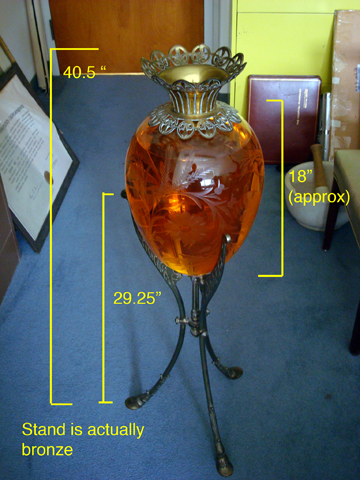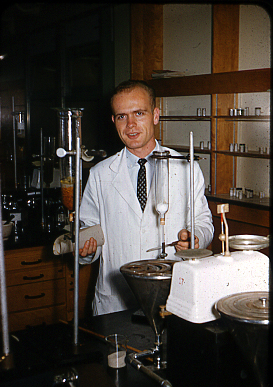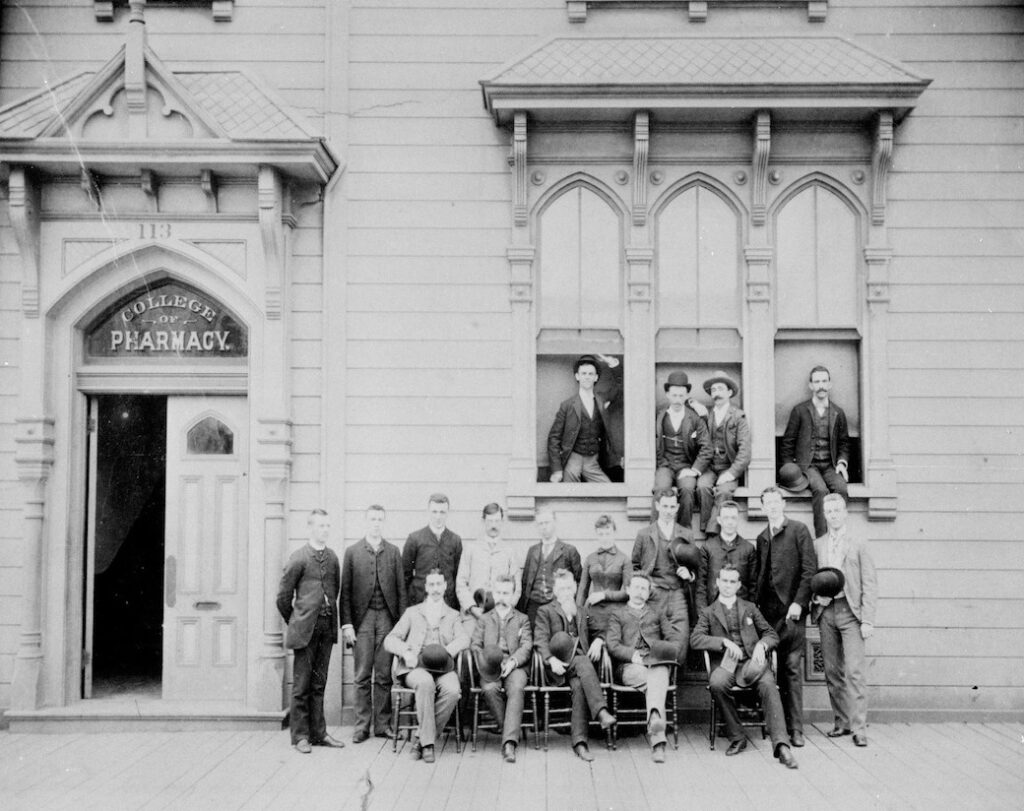A slide of the Bay Bridge at dusk in 1947 from the Robert L. Day collection, MSS 2011-23.
Hope you all have a wonderful holiday weekend!

A slide of the Bay Bridge at dusk in 1947 from the Robert L. Day collection, MSS 2011-23.
Hope you all have a wonderful holiday weekend!
Bob Day: An Oral History
When Robert (Bob) Day retired from UCSF in 2012, his legacy could be measured not only in the number of years of service, students taught, and jokes cracked but also in pounds, volume, and linear feet. Readers of this blog know from recent posts that Bob Day was an inveterate collector of material related to the history of pharmacy in general and the UCSF School of Pharmacy in particular, and the material he accumulated over his 50 years with the university was donated to the UCSF Library’s Archives and Special Collections. The materials processed by archivists totaled 40 linear feet, over 45 boxes, and an untold number of individual items. You might be asking yourself, what does all of this material tell us? What is its significance? And what kind of person would be compelled to collect all of these items?
All of those questions were asked – and many of them answered – in a long, detailed, interesting, and rollicking oral history interview I conducted with Bob in the first three months of 2013. In partnership with the UCSF School of Pharmacy and the UCSF Library’s Archives and Special Collections, the Regional Oral History Office of the Bancroft Library at UC Berkeley planned and conducted this interview. In all, a little over 12 hours of interviews were committed to videotape, which were then transcribed, edited, and, now, made available to you here: http://digitalassets.lib.berkeley.edu/roho/ucb/text/day_bob_public.pdf.
What transpired in those dozen hours? Continue reading
Conservation treatment of a portrait of William M. Searby
William Martin Searby (1835-1909) was an important figure in the founding of the California College of Pharmacy (later UCSF School of Pharmacy). In addition to being the school’s first professor of Materia Medica, and later professor of pharmacy, he was also dean of the college for many of the school’s early years.
A portrait of Professor Searby in the UCSF archives, taken perhaps in the 1880s, was found in disrepair. The portrait was done in a format known as a crayon enlargement, which is a photographic image enlarged onto paper and enhanced by painting over in various media including airbrush, watercolor, or charcoal. Crayon enlargements were introduced in the late 1850s with the introduction of the solar enlarger—a means for enlarging negatives using the sun. They continued to be popular into the early 20th century and can be found on the walls of your local antique shop, often in large numbers. They can be oval shaped and mounted onto convex boards and placed in oval frames, or like the Searby portrait they can be lined with fabric and then mounted onto a wooden strainer. The Searby portrait had a silver-based photographic image as its base and was worked over primarily with charcoal. It was still housed in its original 5” Florentine gilded frame, but the portrait had suffered over time due to light exposure, variations in relative humidity, a poor-quality paper support, and the wooden strainer. These led to losses, yellowing of the image, embrittlement of the paper, and large tears.
The portrait was brought to the photograph conservators at Gawain Weaver Art Conservation in San Anselmo, CA. The first step was to unframe the portrait and cut it away from the wooden strainer and then remove its fabric lining. The loose areas of the lining fabric were cut away with a surgical scalpel. However, the lining fabric was strongly adhered to the fragile print along the edges with a very stubborn adhesive. An enzyme poultice was used to weaken the starch component of the adhesive, but it was still very difficult to remove and had to be slowly mechanically separated after softening with enzymes. The print was then free from its support but the paper was still very brittle, yellowed, and in multiple pieces. The next step was to wash the paper to remove degradation products and restore some flexibility to the print and to light bleach the print to remove the overall yellowing and discoloration.
Light bleaching uses the free radicals generated by light interacting with water molecules to gently remove staining and discoloration in a print while it is being washed. Light bleaching was developed in Marin County by pioneering paper conservator Keiko Keyes in the early 1980s and since that time has been widely adopted by both paper and photograph conservators.
The pieces of the print were placed on a support and washed and light bleached until the discoloration was sufficiently removed and some flexibility had been restored. The fragile print needed mending and physical support, so these were accomplished together by lining the print with a thin and strong sheet of Japanese paper attached with wheat starch paste, the most stable and commonly used adhesive in the conservation of photographs and works on paper. The mended cracks and remaining losses were then filled and retouched to make them all but invisible to the viewer.
The original aesthetic of the portrait was perfectly flat. To achieve that flatness and to provide further physical support, the newly lined print was mounted overall to a sheet of 4-ply rag museum board. The glass was replaced with UV-filtering acrylic to eliminate the danger of breaking glass and provide protection from ultraviolet light. The old nails keeping the two parts of the frame together were dangerous and often very loose, so they were removed and the frame and print were assembled more securely to be put on display for the first time in many years outside the UCSF archives.
Gawain Weaver
Photograph Conservator
Gawain Weaver Art Conservation
http://gawainweaver.com/
A Processing Prescription for School of Pharmacy History
Have you visited the 5th floor of the UCSF Library lately? If so, you might have seen the latest UCSF Archives and Special Collections exhibit featuring items from the new Robert L. Day Collection. With photographs, scrapbooks, letters, books, and dozens of curious artifacts, the collection illustrates School of Pharmacy history from 1872 to the present day.
When School of Pharmacy Associate Dean Robert Day retired after a distinguished 50-year career at UCSF, his office was bursting at the seams with historical items he had collected. From 19th-century faculty meeting minutes to recent academic plans and reports, from the School’s 1873 Inaugural Address to the research that pioneered the Clinical Pharmacy Program in 1966, his collection tells the story of more than a century of education and innovation in pharmacy practice at UCSF.

Show globes containing colored liquid were displayed in shop windows to identify the business as a pharmacy or drug store. This show globe belonged to Otto A. Weihe (1896-1961), an alumnus and instructor of the California College of Pharmacy. It contains the original colored liquid used by Weihe family when the globe was installed in the Modesto, CA pharmacy in 1911. Robert L. Day Collection, MSS 2011-23, UCSF Archives & Special Collections.
In addition to papers and photographs, Professor Day gathered enormous pharmacy ledgers containing prescriptions from the 1930s and 1940s, reels of 16mm film and audio tapes, and curious artifacts like a liquid-filled glass show globe. He generously donated these materials to the UCSF Library in 2012.
I joined the Archives and Special Collections staff from November 2012-May 2013 as a Project Archivist to process the Day collection and to prepare it for research and exhibit use. It was fascinating to peruse items like 19th-century textbooks from “Materia Medica” courses and to examine boxes of patent medicines for ailments like “dyspepsia” and “pleurisy.” I cataloged leather-bound volumes of faculty meeting minutes and reviewed letters from dozens of alumni recounting colorful stories of their early-twentieth-century student days and later careers. (A complete collection description and research guide is available on the Online Archive of California.) Continue reading

Robert Day as a student, in a UCSF School of Pharmacy lab, 1957. Robert L. Day Collection, MSS 2011-23.
We were fortunate this past spring to benefit from the generosity of Dr. Robert Day and the expertise of the Library’s Archives and Special Collections. Dr. Day retired in 2012 from the UCSF School of Pharmacy faculty after an accomplished 50+-year academic career at UCSF. He retired as well from his unofficial position as the School’s historian. He was a magnet for all things old and wonderful related to the School and pharmacy in general. His office was a floor-to-ceiling treasure trove, the precious contents of which he generously donated to UCSF upon his retirement. The new Robert L. Day Collection is complete with the 1906-1910 School of Pharmacy faculty meeting minutes; glorious show globes, the predecessors of which were used originally to mark the physical location of a pharmacy; a 1930 prescription for one pint of whiskey (undiluted); photos of our bell-bottomed and side-burned faculty members in the 60’s; and priceless detailed documents showing the transformation here at UCSF of pharmacy into a clinical profession. Coming soon is Dr. Day’s oral history, a must read. Just as impressive as the items in the collection was the skilled and focused work of the archive professionals in the Library. Under the direction of UCSF Archivist Polina Ilieva, the boxes and boxes of precious items from Dr. Day’s office were collected, preserved, digitized, and catalogued into a findable resource that is now accessible worldwide. I encourage anyone who might have archival documents or special collections of health- or science-related items to contact the Library. In the meantime, enjoy the Robert L. Day Collection.
Susan Levings, MS
Associate Dean, Planning and Communications
UCSF School of Pharmacy

Group of pharmacy students from the class of 1889 posing in front of California College of Pharmacy building at 113 Fulton Street, San Francisco. Otto A. Weihe (later Instructor of Materia Medica at the College) is standing 2nd from left. Robert L. Day Collection, MSS 2011-23.
In April of 2013 the UCSF Archives unveiled recently acquired Robert L. Day collection documenting the history of the School of Pharmacy. This project included not only arrangement and processing of the collection, but also preservation and restoration of damaged oversized photographs, digitization, design and creation of a companion digital portal, physical and online exhibits, oral history and organization of events to showcase the history of the School. It was successfully accomplished as a result of the close cooperation between the School’s leadership and the Library. With the approval and continuing personal involvement of the dean, B. Joseph Guglielmo, PharmD., the School of Pharmacy provided generous support and funded the hiring of a part-time processing archivist for a period of six months, digitization of brittle scrapbooks and photographs, work of a photo conservator, and an oral historian.
In the next couple of weeks we will bring to your attention entries written by the participants of this project…